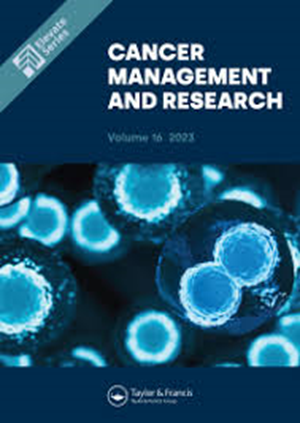新诊断的骨髓增生异常综合征患者自然杀伤细胞水平低可能预后不佳:一项回顾性队列研究
IF 2.5
4区 医学
Q3 ONCOLOGY
引用次数: 0
摘要
背景:新的研究表明,免疫失衡似乎在肿瘤生长中起着关键作用。外周淋巴细胞亚群被认为能反映全身免疫反应和临床预后。骨髓增生异常综合征(MDS)患者淋巴细胞亚群的预后价值仍不明确:方法:本研究共纳入 94 名 MDS 患者。采用 X-tile 软件确定各种淋巴细胞亚群(CD3、CD4、CD8、CD4/CD8 比值、自然杀伤细胞(NK)和 CD19)的预后意义。其中,只有 NK 百分比能找到合适的阈值。患者被分为高 NK 百分比组和低 NK 百分比组。通过单变量和多变量 Cox 危险模型确定预后意义:结果:NK水平较低的MDS患者总生存期(OS)明显较短。单变量分析显示,男性(P = 0.030)、较低 HB(< 10 g/dl,P = 0.029)、较高 BM blast(> 5%,P < 0.0001)、较高风险 IPSS-R 细胞遗传学(P = 0.032)和较低 NK 百分比(P < 0.0001)与较短的 OS 显著相关。多变量考克斯比例危险回归分析表明,低NK也是MDS患者OS的独立不良预后因素:结论:NK水平降低可预测不良预后,与IPSS-R无关,为MDS患者提供了一个新的评估因素。本文章由计算机程序翻译,如有差异,请以英文原文为准。
Low Levels of Natural Killer Cell in Newly Diagnosed Myelodysplastic Syndromes Patients May Confer Poor Prognosis: A Retrospective Cohort Study
Background: Immune imbalance appears to have a critical role in tumor growth according to emerging research. Peripheral lymphocyte subsets are considered to reflect the systemic immune response and clinical prognosis. The prognostic value of lymphocyte subpopulations in myelodysplastic syndrome (MDS) patients remains unclear.
Methods: A total of 94 MDS patients were enrolled for the study. X-tile software was performed to determine the prognostic significance of various lymphocyte subpopulations, CD3, CD4, CD8, CD4/CD8 ratio, natural killer cell (NK) and CD19. Among them, the appropriate threshold of NK percent could be found only. Patients were divided into the high NK percent group and the low NK percent group. The prognostic significance was determined by univariate and multivariate Cox hazard models.
Results: MDS patients with lower NK level had significantly shorter overall survival (OS). Based on univariate analysis, male gender (P = 0.030), lower HB (< 10 g/dl, P = 0.029), higher BM blast (> 5%, P < 0.0001), higher-risk IPSS-R cytogenetic (P = 0.032) and lower NK percent (P < 0.0001) were significantly associated with shorter OS. Multivariate Cox proportional hazards regression analysis indicated that low NK was also independent adverse prognostic factor for OS in MDS.
Conclusion: Decreased NK level predicts poor prognosis independent of the IPSS-R and provide a novel evaluation factor for MDS patients.
Methods: A total of 94 MDS patients were enrolled for the study. X-tile software was performed to determine the prognostic significance of various lymphocyte subpopulations, CD3, CD4, CD8, CD4/CD8 ratio, natural killer cell (NK) and CD19. Among them, the appropriate threshold of NK percent could be found only. Patients were divided into the high NK percent group and the low NK percent group. The prognostic significance was determined by univariate and multivariate Cox hazard models.
Results: MDS patients with lower NK level had significantly shorter overall survival (OS). Based on univariate analysis, male gender (P = 0.030), lower HB (< 10 g/dl, P = 0.029), higher BM blast (> 5%, P < 0.0001), higher-risk IPSS-R cytogenetic (P = 0.032) and lower NK percent (P < 0.0001) were significantly associated with shorter OS. Multivariate Cox proportional hazards regression analysis indicated that low NK was also independent adverse prognostic factor for OS in MDS.
Conclusion: Decreased NK level predicts poor prognosis independent of the IPSS-R and provide a novel evaluation factor for MDS patients.
求助全文
通过发布文献求助,成功后即可免费获取论文全文。
去求助
来源期刊

Cancer Management and Research
Medicine-Oncology
CiteScore
7.40
自引率
0.00%
发文量
448
审稿时长
16 weeks
期刊介绍:
Cancer Management and Research is an international, peer reviewed, open access journal focusing on cancer research and the optimal use of preventative and integrated treatment interventions to achieve improved outcomes, enhanced survival, and quality of life for cancer patients. Specific topics covered in the journal include:
◦Epidemiology, detection and screening
◦Cellular research and biomarkers
◦Identification of biotargets and agents with novel mechanisms of action
◦Optimal clinical use of existing anticancer agents, including combination therapies
◦Radiation and surgery
◦Palliative care
◦Patient adherence, quality of life, satisfaction
The journal welcomes submitted papers covering original research, basic science, clinical & epidemiological studies, reviews & evaluations, guidelines, expert opinion and commentary, and case series that shed novel insights on a disease or disease subtype.
 求助内容:
求助内容: 应助结果提醒方式:
应助结果提醒方式:


